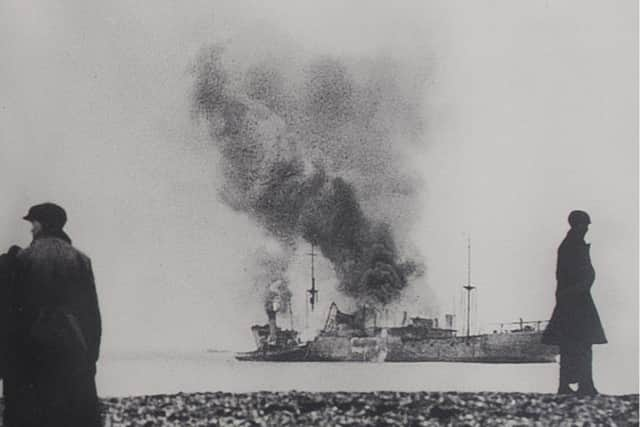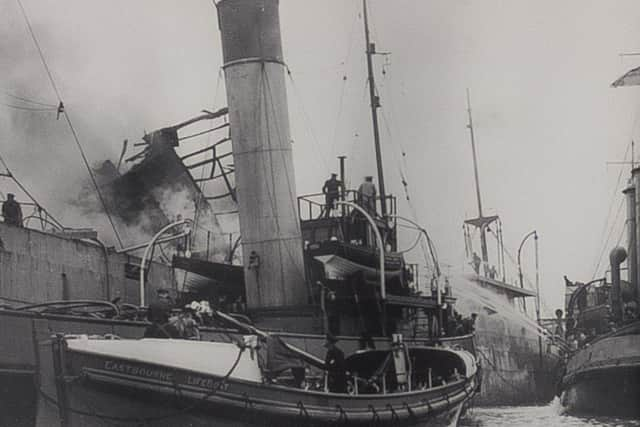Eastbourne RNLI’s 200th anniversary: the story of the SS Barnhill
and live on Freeview channel 276
To commemorate this momentous date, we continue with our series of historical articles, each examining a significant event in Eastbourne’s lifeboat history which occurred ‘this week in time’.
This week we bring you the story of the SS Barnhill, a tale of wartime heroism during the night of March 20–21, 1940, that saw two of the Eastbourne lifeboat crew receive bronze medals from the RNLI for their bravery during a remarkable rescue.
Advertisement
Hide AdAdvertisement
Hide AdBritain had entered World War Two in September 1939 and the reality of the conflict was brought home in March 1940 when the Barnhill was bombed by a German fighter aircraft six miles off Beachy Head.


This was the first time that a merchant navy ship had been attacked from the air by the Luftwaffe.
The Barnhill, a 5,430-ton merchant steam-ship, was heading up the Channel on its way to London from Halifax, Canada on the evening of March 20 with a crew of 34 and a mixed cargo including timber, carbide, zinc and copper ingots and large quantities of tinned food, when the German bomber struck.
Bombs hit the vessel amidships and down the funnel, and the timber and carbide ignited causing a large fire on board – followed by a series of explosions.
Advertisement
Hide AdAdvertisement
Hide AdThe ship’s bridge was blown onto the foredeck and five of the crew were killed or lost at sea.


The ship’s distress signals were picked up by a Dutch merchant vessel, which managed to rescue 18 of the survivors.
At 11.15pm the Eastbourne lifeboat, the Jane Holland, was launched into the darkness with its crew led by Coxswain Michael Hardy.
The Jane Holland was a large motor-lifeboat of wooden construction, a 40 ft. self-righter, powered by a petrol engine - she had served at Eastbourne since 1929.
Advertisement
Hide AdAdvertisement
Hide AdThe lifeboat reached the stricken Barnhill at 1.40am, collected the 18 survivors from the Dutch vessel, then drew alongside the blazing steamer to look for more survivors.
The ship was now burning fiercely, and there were frequent explosions below decks, but the lifeboat men managed to find and rescue 10 more people.
With the crew believing that all survivors had been rescued, they returned to shore.
The Barnhill drifted helplessly offshore, now clearly visible from Eastbourne seafront.
Advertisement
Hide AdAdvertisement
Hide AdThe alarm had been raised on shore, and staff and guests rushed from the Grand Hotel and worked through the night to help the survivors.
A salvage tugboat then arrived from Newhaven to assist the blazing ship.
At 4.45am the Eastbourne lifeboat station received an urgent message from the tug – the Newhaven crew had heard the Barnhill’s bell being rung and had spotted an injured man among the debris on the forecastle.
The man was so badly hurt he could hardly move, but he had managed to crawl along the deck and pull the bell’s cord with his teeth.
The lifeboat was launched again, taking a doctor with her.
Advertisement
Hide AdAdvertisement
Hide AdThe tug had been unable to get alongside the ship, but the lifeboat arrived and was able to close in for a hazardous rescue attempt.
When she reached the steamer the ship was rolling heavily and flames were shooting 90 ft into the air.
Explosions were still coming from the vessel and the fire was spreading rapidly.
Lifeboat men Alec Huggett and Thomas Allchorn then volunteered to go aboard the burning steamer to try and rescue the injured man.
Advertisement
Hide AdAdvertisement
Hide AdAs dawn began to break, the two lifeboat men boarded the Barnhill where they found themselves amidst a tangled mess of burning debris.
As they cautiously made their way forward, the master of the tug sprayed a fire hose behind them, to check the spread of the flames.
The injured man turned out to be the Barnhill skipper, Captain Michael O’Neil.
He had been trapped under the wreckage and the crew had assumed he was missing and dead.
Advertisement
Hide AdAdvertisement
Hide AdMr O’Neil was in a very bad way - it was later found he had suffered a double fracture of the arm, a fractured collar-bone, five broken ribs (one of which had pierced his lung), severe burns and a concussion.
The man was drifting in and out of consciousness, but he continued to pull the cord of the ship’s bell with his teeth to alert the two lifeboat men to where he was.
The lifeboat coxswain, Mr Hardy, held the Jane Holland alongside the burning steamer.
With the doctor shouting instructions to Mr Huggett and Mr Allchorn, they managed to carefully lower the injured skipper into the lifeboat.
The lifeboat returned to shore at 7.20am.
Advertisement
Hide AdAdvertisement
Hide AdCaptain O’Neil was rushed to hospital and, despite his injuries, he went on to make a good recovery.
By 8am the lifeboat was on the sea again to help the crew of the tug to fight the fire on the Barnhill.
The lifeboat was finally able to return to her boathouse at noon, more than 12 hours after she had originally been launched.
Having been successfully evacuated, the Barnhill was eventually towed inshore, where she ran aground at Langney Point – just outside Sovereign Harbour.
Advertisement
Hide AdAdvertisement
Hide AdThe ship then broke up, spilling her cargo into the sea, where it was washed up on Eastbourne’s beaches.
Crowds of local residents, worn down by wartime rationing, thronged to the shore to help themselves to the cans of tinned food.
Eighty-two years later, the wreckage of three of the ship’s boilers can still be seen off Langney Point at low tide.
These are the last remains of the SS Barnhill, although the ship’s bell – which was so crucial to the survival of Captain O’Neil - was salvaged and is currently on display at Eastbourne’s RNLI museum in King Edward’s Parade.
Advertisement
Hide AdAdvertisement
Hide AdA couple of weeks after the rescue, on April 8, the Eastbourne Herald reported that the owners of the Barnhill had donated £105 to the RNLI in recognition of the gallantry of the lifeboat men in saving the crew from the blazing ship.
At a dinner in the Gildredge Hotel, the mayor, Alderman Arthur Edward Rush, paid tribute to the heroism of the lifeboat men and particularly to Mr Huggett and Mr Allchorn.
The following month it was announced that the men were each to be awarded RNLI bronze medals in recognition of their bravery in reboarding the disabled Barnhill.
This was a fitting tribute to two men whose families had given (and continued to give) many generations of service to the Eastbourne lifeboat crews.
Advertisement
Hide AdAdvertisement
Hide AdCoxswain Hardy also received a framed letter of appreciation from the RNLI.
On June 11, after several months recovering in hospital, Captain O’Neil met the Eastbourne Ladies’ Lifeboat Guild in the mayor’s parlour.
He stood and publicly paid tribute to the bravery of the lifeboat men who had risked their lives to save him and his crew, saying ‘there is no doubt that I owe my life to those grand fellows.’